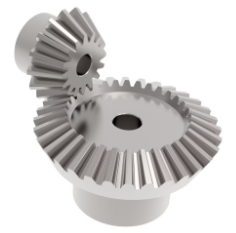Bevel gears are a type of gear designed to transmit power between shafts that intersect, typically at a 90-degree angle. They have conically shaped teeth and are used in applications requiring changes in the direction of rotation.
Key Features of Bevel Gears:
- Conical Shape – Teeth are arranged along the surface of a cone rather than a cylinder.
- Non-Parallel Shafts – Designed for shafts that intersect at an angle (commonly 90° but can vary).
- Types of Bevel Gears:
- Straight Bevel Gears – Teeth are straight and similar to spur gears; used for lower speeds.
- Spiral Bevel Gears – Teeth are curved, providing smoother engagement and reduced noise.
- Hypoid Gears – A variation where shafts do not intersect, common in vehicle differentials.
- Zerol Bevel Gears – Similar to spiral bevel gears but with zero curvature, acting like straight bevel gears.

Advantages:
✔ Transmits power between intersecting shafts
✔ Provides smooth and efficient power transfer
✔ Available in different tooth configurations for varied applications
✔ Spiral bevel gears reduce noise and increase load capacity
Disadvantages:
✖ More complex to manufacture than spur gears
✖ Alignment must be precise for proper operation
✖ Higher cost due to complex geometry
Common Applications:
- Automotive Differentials – Used in vehicle axles to allow wheels to rotate at different speeds.
- Power Tools – Drills and grinders use bevel gears for efficient power transfer.
- Industrial Machinery – Used in conveyor belts, elevators, and printing presses.
- Marine & Aviation – Gear systems in ships and aircraft propulsion systems.